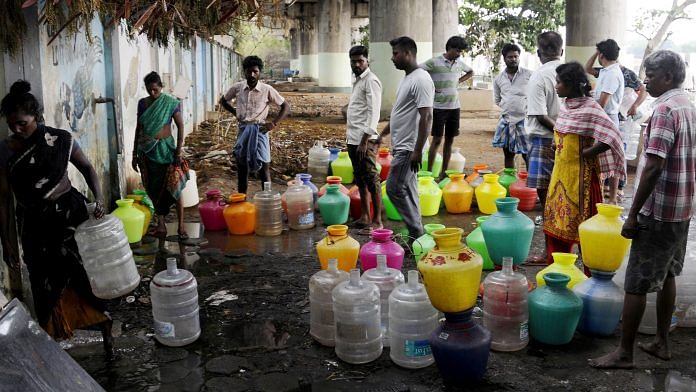Thank you dear subscribers, we are overwhelmed with your response.
Your Turn is a unique section from ThePrint featuring points of view from its subscribers. If you are a subscriber, have a point of view, please send it to us. If not, do subscribe here: https://theprint.in/
The world is facing a looming global water crisis that threatens to “spiral out of control” as increased demand for water and the intensifying impacts of the climate crisis put huge pressure on water resources, warns the UN World Water Development Report 2023. Despite its importance and its scarcity, man has exploited and polluted water reservoirs more than any other resource. Availability of good quality water has thus, emerged as a major problem in various parts of the world and the situation is likely to worsen in the future. Factors such as climate change and population growth are expected to affect severely the future availability of water from freshwater sources.
Let’s talk with the biggest use of water: our food. But the big issue we may be overlooking is the relationship between food, water, and climate change. Climate change has led to drought and less predictable access to water for agriculture and food production in many parts of the world. By 2050, estimates predict that the total number of people living on Earth will reach nearly 10 billion. More people on the planet mean more mouths to feed. Every person needs 50 to 100 liters of water per day to meet basic drinking, cooking, and hygiene requirements. By comparison, it takes 2,000 to 5000 liters of water per person per day to grow the food to support diets of 2,800 kilocalories daily. The United Nations anticipates agricultural production will have to grow 50 percent to meet rising demands in 2050, prospectively requiring global water withdrawals 30 percent higher than today. Yet an estimated 2.4 billion people now live in countries confronting water stress and almost 40 percent of global croplands already experience water scarcity, fueling concerns that mounting needs risk colliding with increasingly strained supplies. Staple crops – rice, wheat, maize and soybeans – make up around two-thirds of the world’s food calories, making them critically important to consumers worldwide. Global production of these staple crops is highly concentrated in regions known as “breadbaskets,” and at least 72% of the global production of each of these crops is found in just five regions. Yet, about 30% of food made for human consumption is wasted globally, using up valuable land and water resources, wasted food equals wasted water. Agriculture is both a cause and casualty of water scarcity. Agriculture consumes more water than any other source and wastes much of that through inefficiencies. Half of the water used by agriculture is extracted privately and is not tracked. For example, the water that farmers pump from rivers, lakes or aquifers is in most cases not metered. With water starting to run out during summer droughts, the lack of data is becoming a problem. If we don’t know how much water we really consume, how do we change our behavior in response to climate change? Prolonged periods of drought have increased the need for water to irrigate agricultural fields, which is sometimes taken from the same underground water reserves that supply homes. The UN Food and Agriculture Organization (FAO) reports that 40% of the world’s food depends on irrigation, which accounts for almost 70% of fresh water used. The first place to save water is in conveyance: as much as 60% of the water withdrawn for irrigation is lost through leaks in canals, spillage and evaporation, according to the FAO. Another part of the problem is flood irrigation – the most common method of field irrigation globally. According to the US Geological Survey, about half the water on flood irrigated fields is not absorbed by crops. Instead it runs off, taking with it fertilizers, pesticides and topsoil that pollute water bodies around the world. In intensive farming regions, groundwater is being extracted at a faster rate than the underground supply is renewed, as well as from non-renewable groundwater sources.
More frequent and severe droughts are having an impact on agricultural production, while rising temperatures translate into increased crop water demand, while deforestation and intensive agriculture dry out soils. So as the soil dries up and the rains fail to fall across many most important growing regions, the looming question remains: “what are we to do?” With simply not enough water to grow food crops, we used to grow much more non-food crops in the most water-stressed regions. Even if we have the water for now, we need to think about the future generation and sustainability. This is likely only the beginning, agricultural water scarcity is expected to increase in more than 80% of the world’s croplands by 2050, according to a new study in the AGU journal Earth’s future.
Encouragingly, water has finally reached the highest levels of global climate negotiations. The path to a sustainable freshwater future, however, lies with ground-level users. COP 28 UAE Presidency announces priorities to drive water up the climate agenda, and placed food systems transformation at the heart of its COP agenda. The Food and Agriculture Organization of the United Nations is working with countries to ensure water use in agriculture is made more efficient, productive, equitable and environmentally friendly. This involves producing more food with less water.
Now the onus is on all of us to hold ourselves accountable, we need to change our habits and act now to protect this precious resource, with the commitments to make every drop count.
These pieces are being published as they have been received – they have not been edited/fact-checked by ThePrint.

